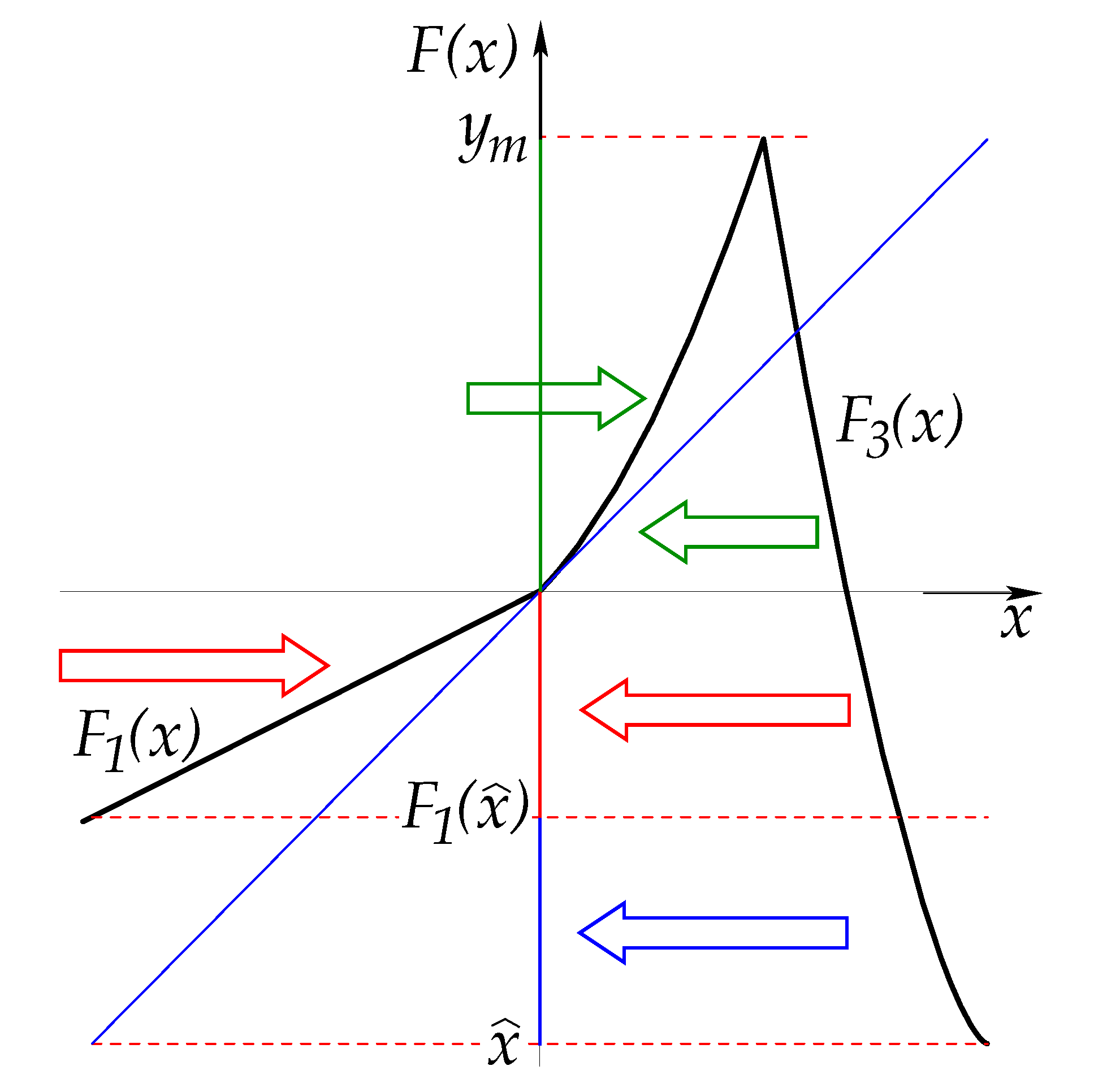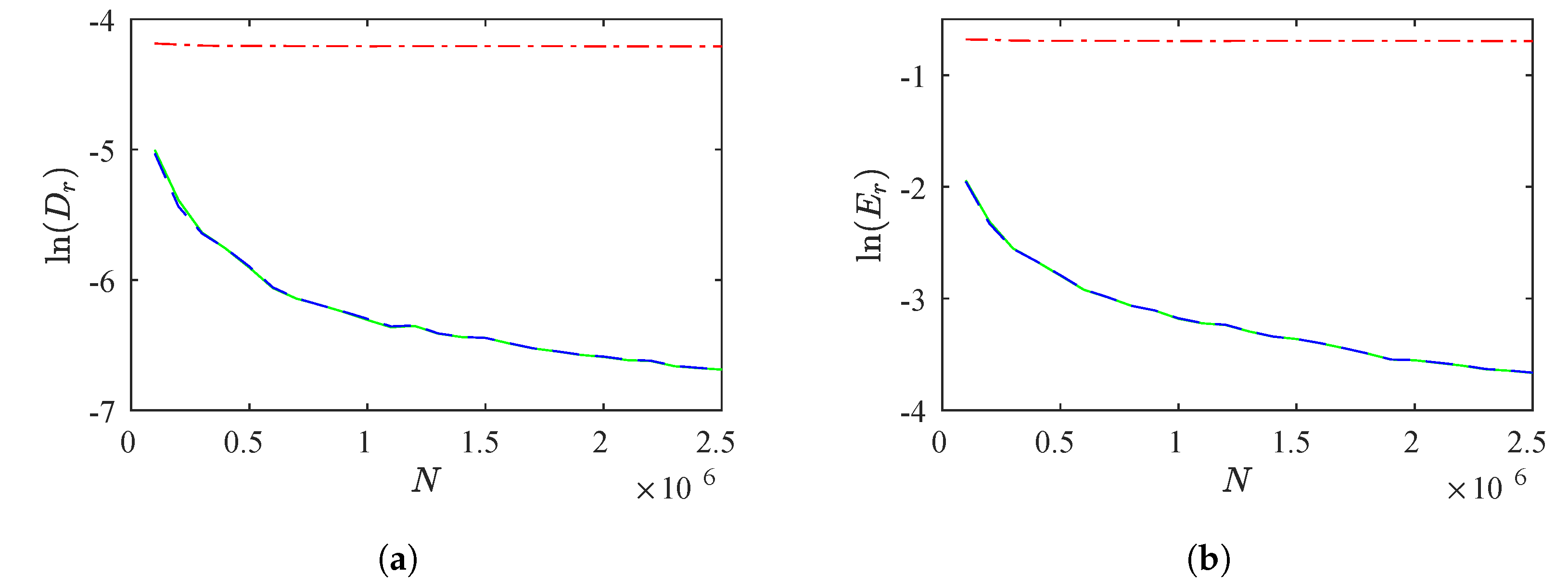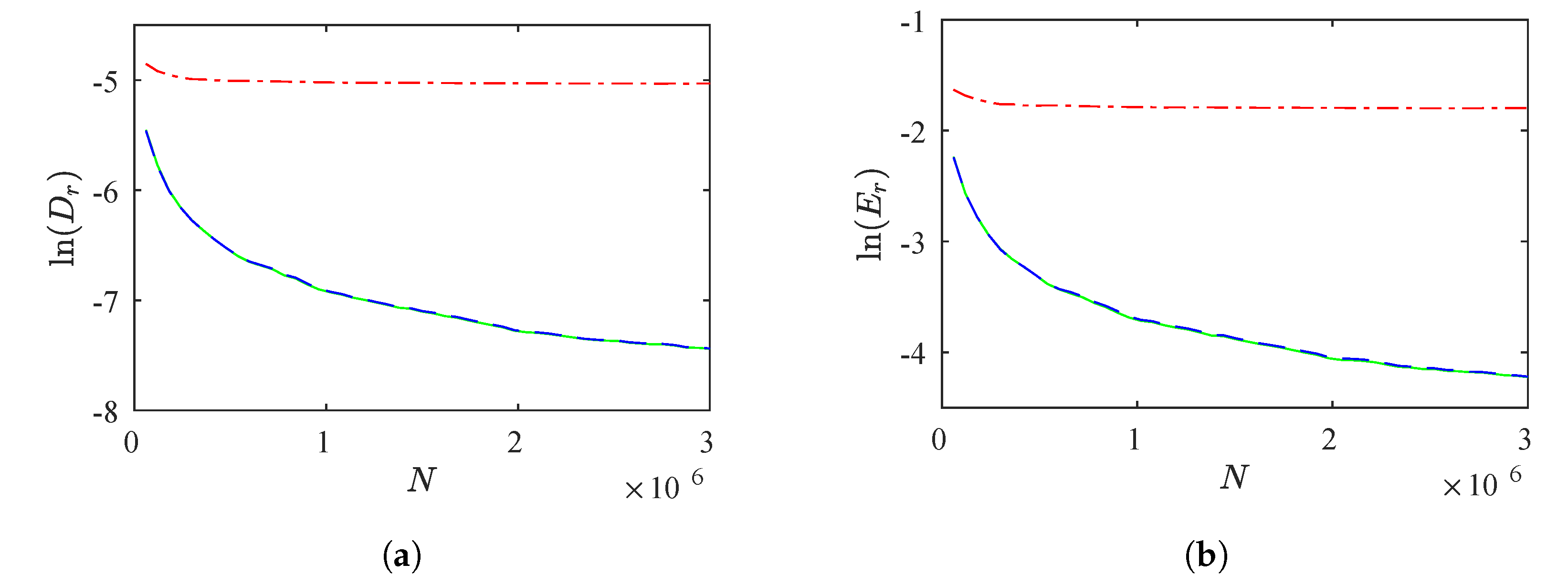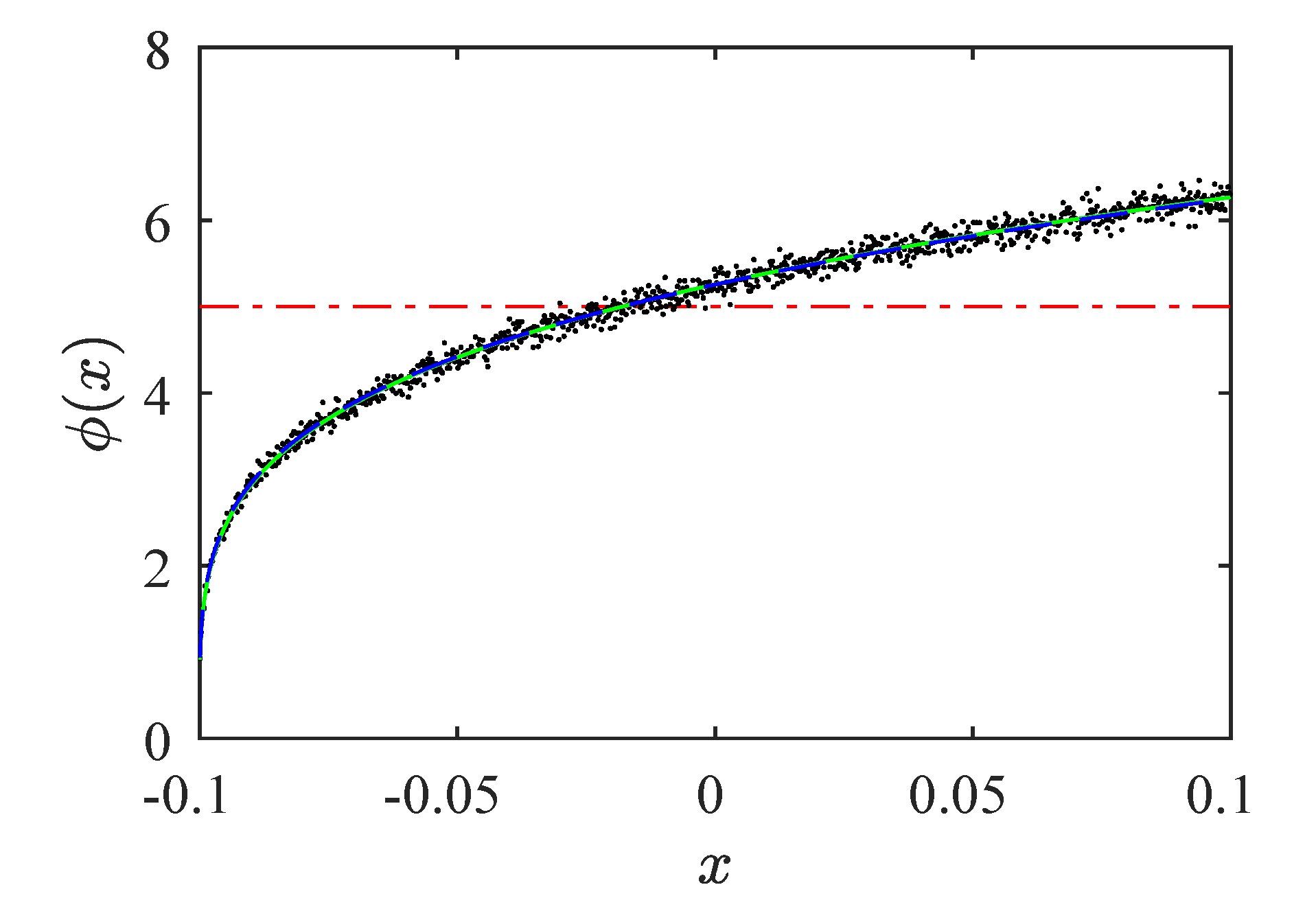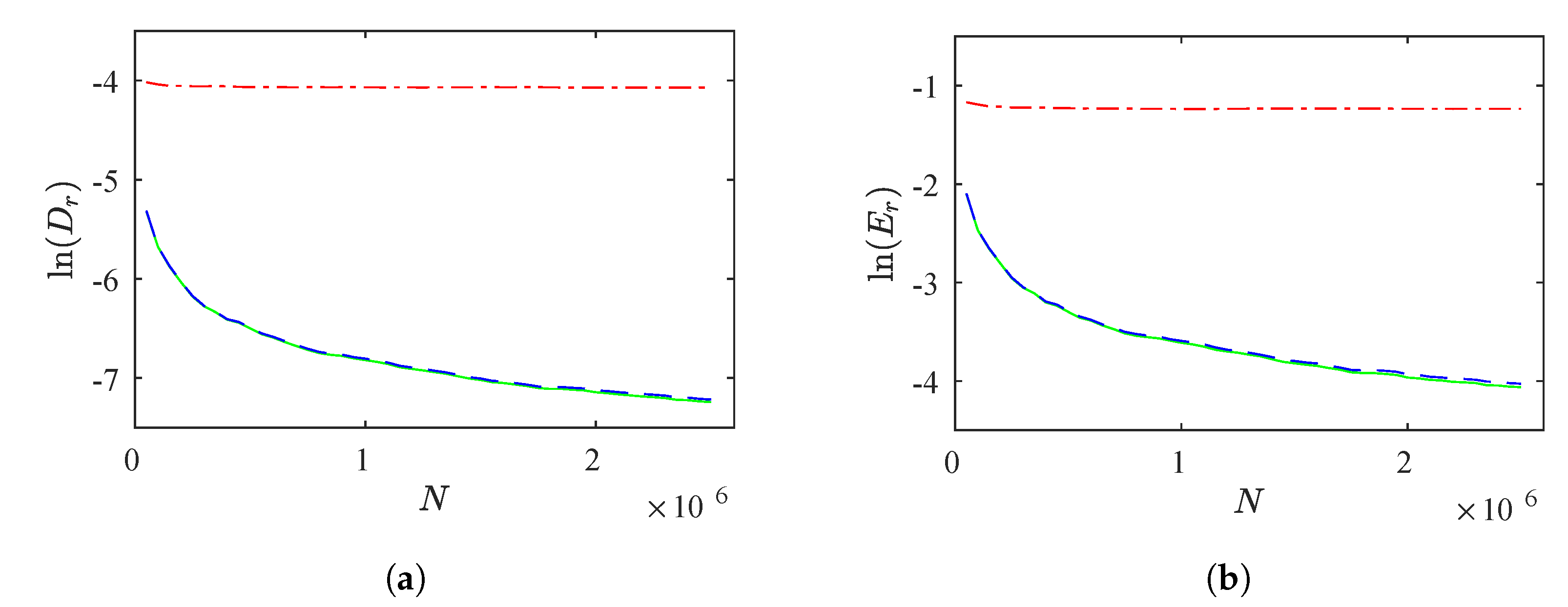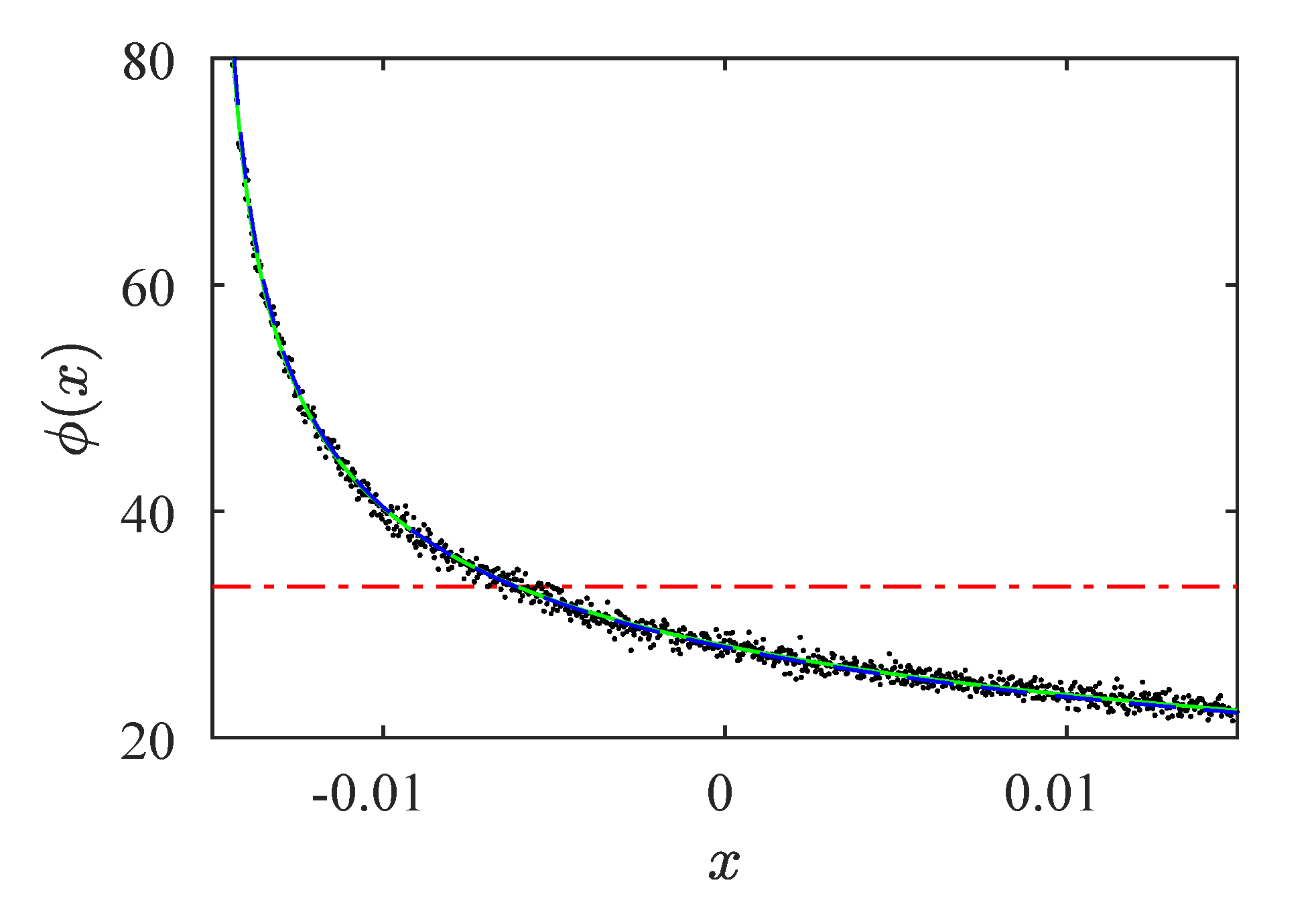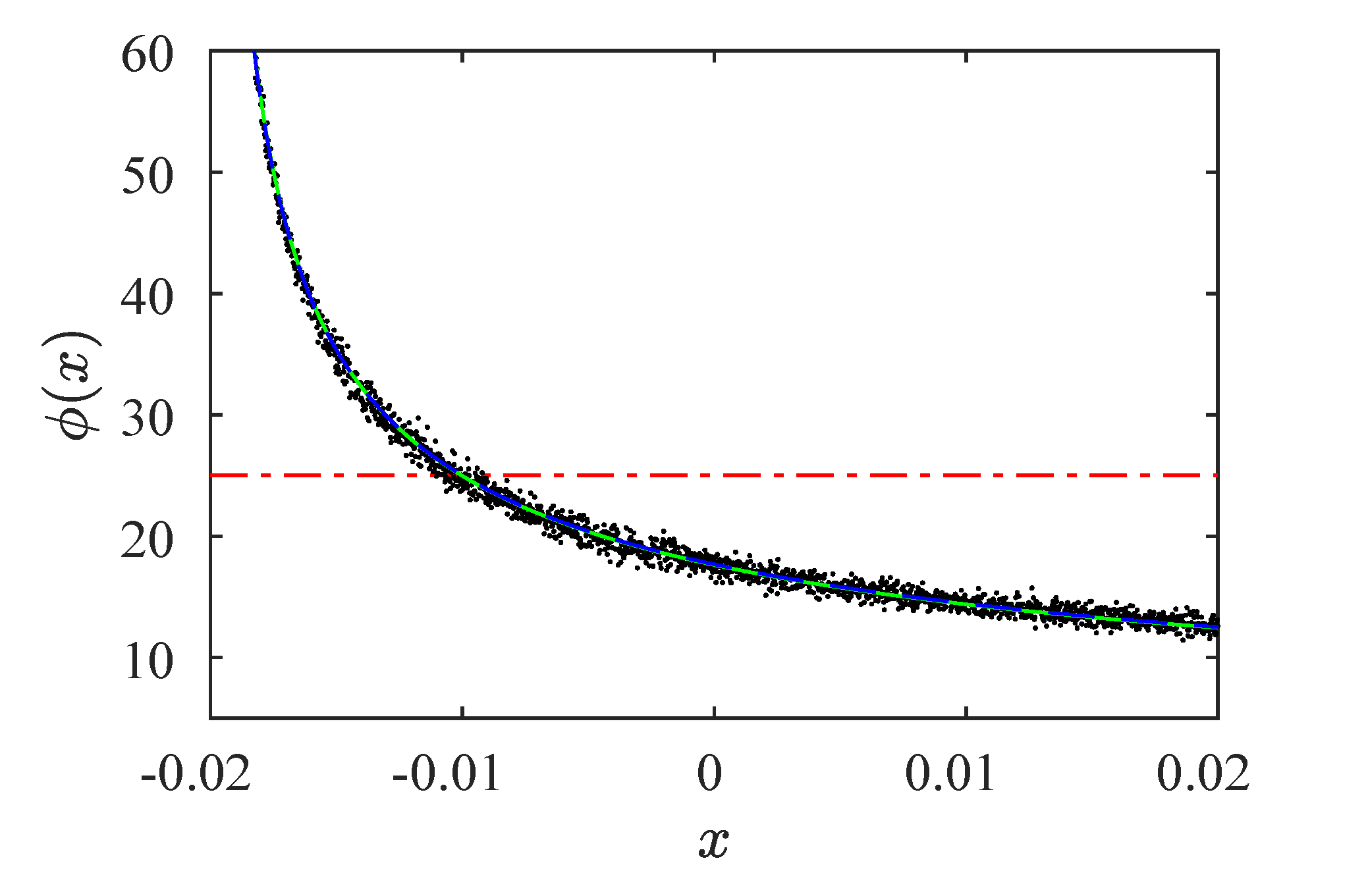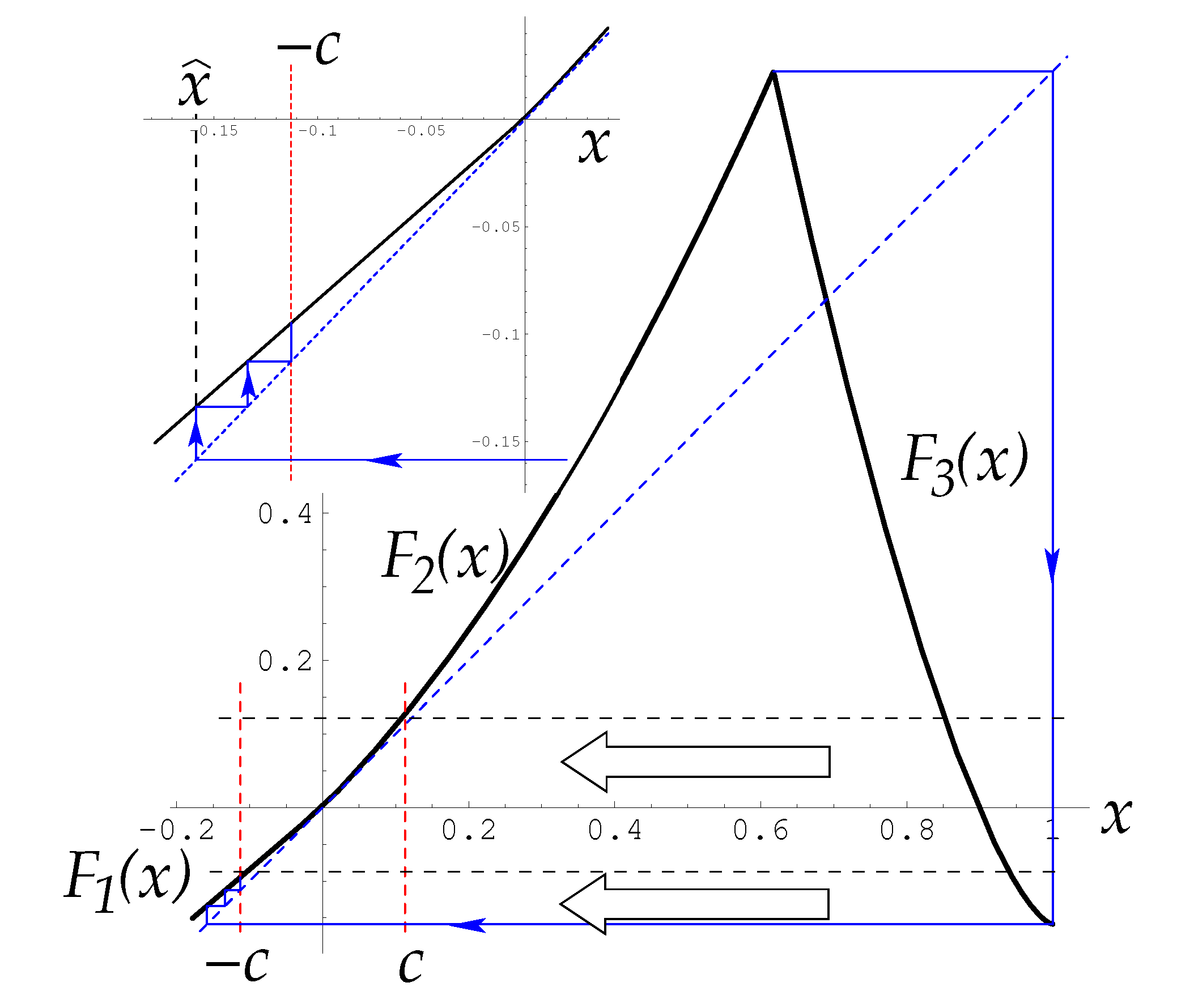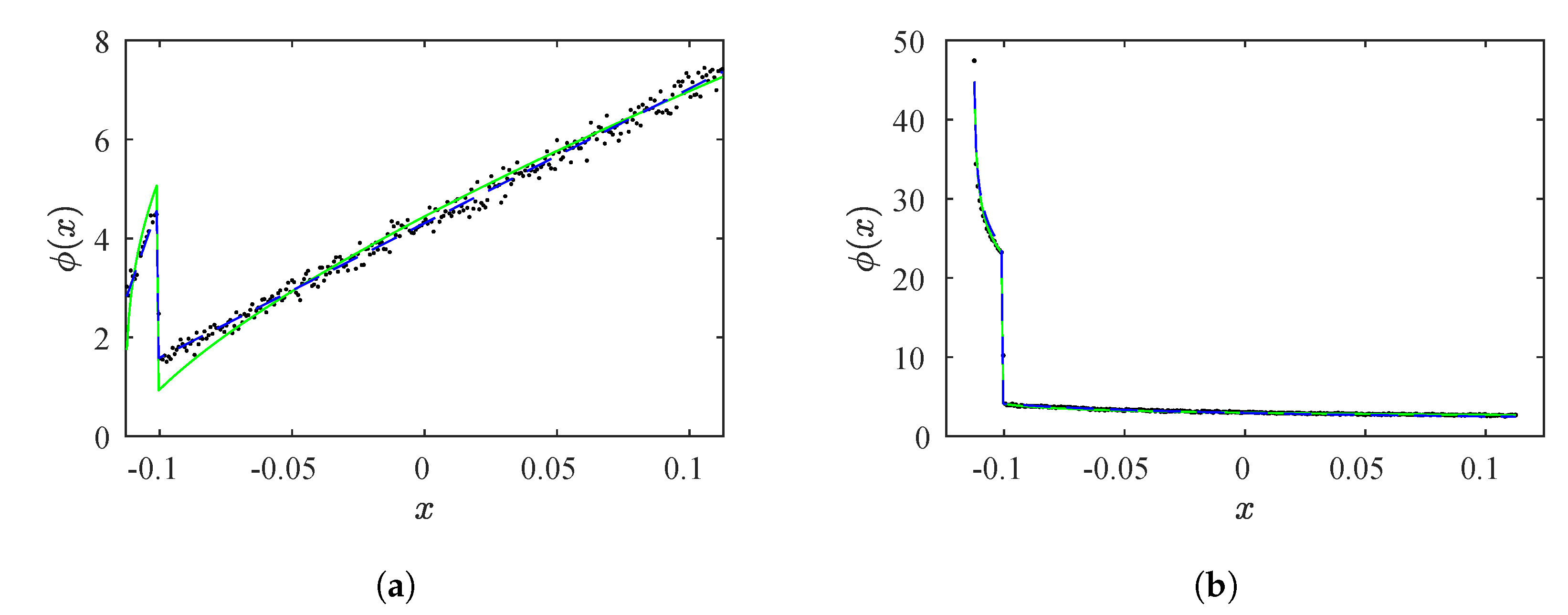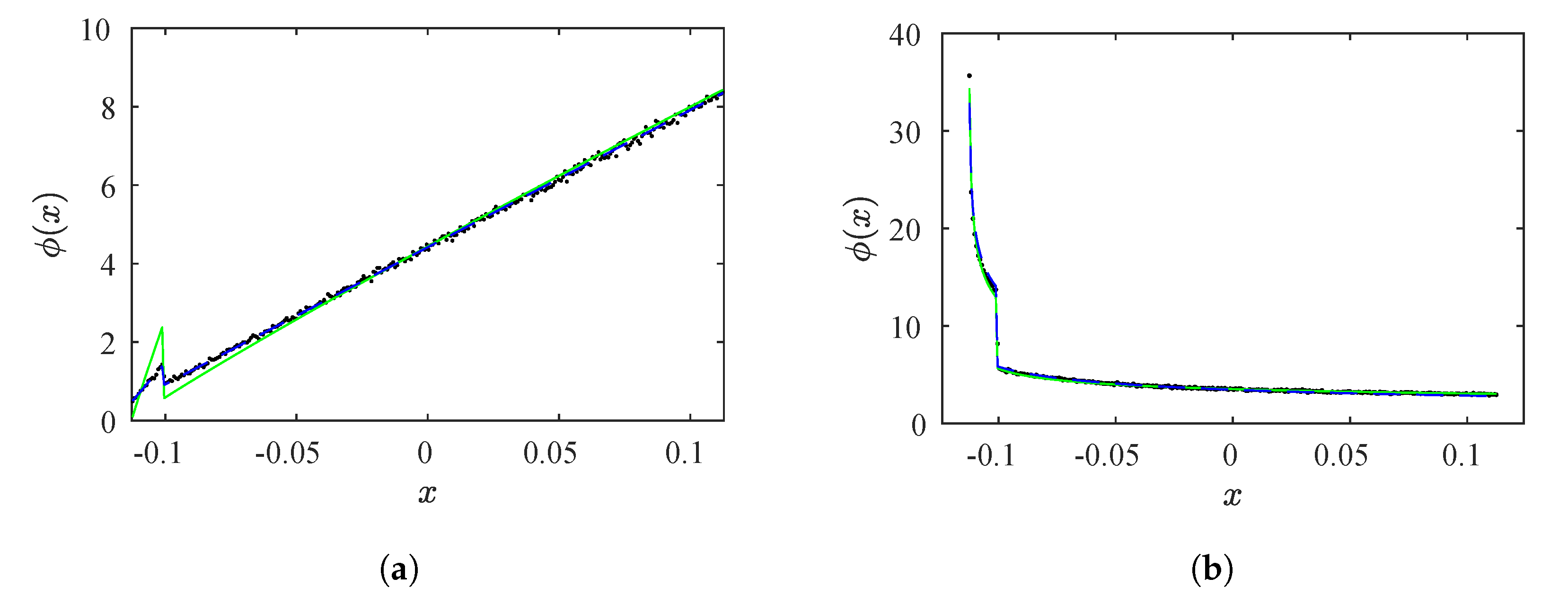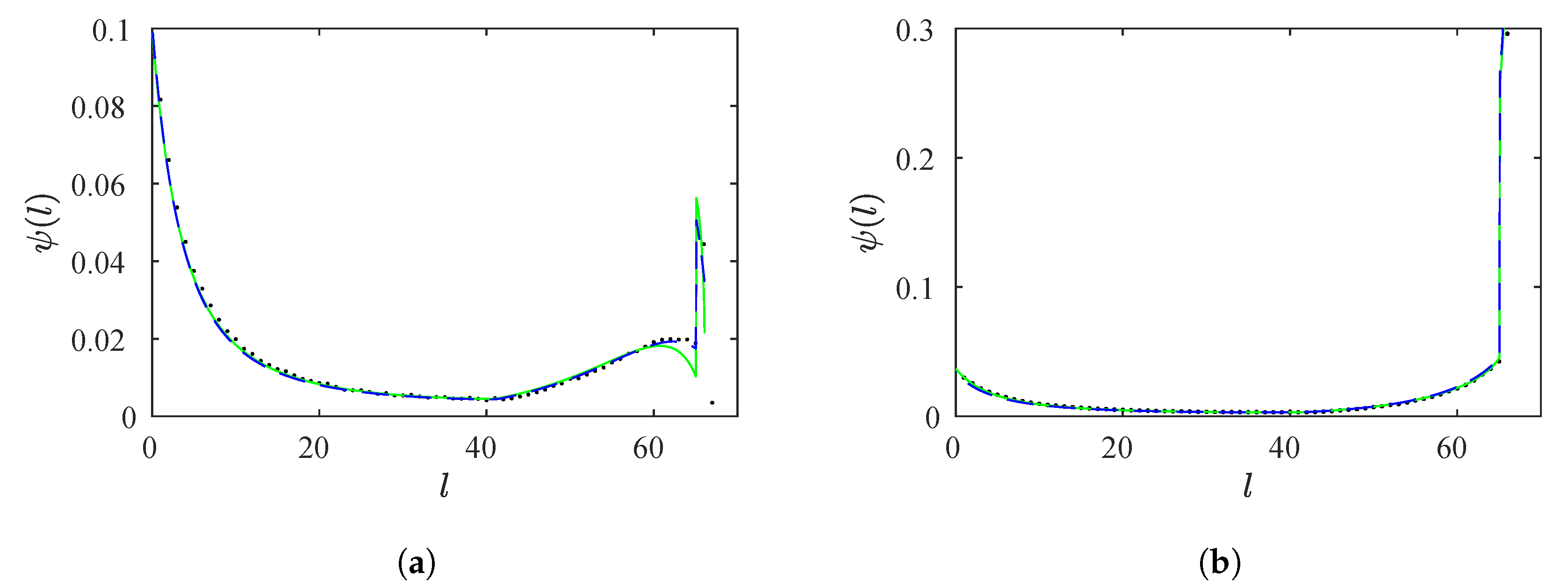The first term in Equation (
11) is the probability for the trajectory to be in
L when in the preceding iteration it has already been there. Subsequently, only the second term in the RHS of Equation (
11) defines the RPD function, denoted here by
, by means of the following relation
where the weight
w is introduced because it is common to normalize the function
over the whole laminar interval
L as
. Next, to evaluate the RPD function the sums in Equation (
3)–(
5) have to exclude the contributions that do not produce reinjection inside of the laminar interval [
4,
35]
where
l indicates the integrals that do not generate reinjection and
is the density in the preceding iteration to reinjection. The normalization condition is
where
c is the semi-amplitude of the laminar interval, and
is the fixed point,
.
2.1. Continuous RPD
Let us consider the lower boundary of reinjection in the family of maps described by Equation (
2) with
,
, and
. Therefore, there is no reinjection from points
because the lower limit of the laminar interval is the lower boundary of reinjection. To obtain the RPD function we use Equations (
13) and (
14). Note that
and
do not produce reinjection, and the RPD can then be calculated as
where
To apply Equation (
15) we have to evaluate the density at pre-reinjection points,
. Let us expand
by a Taylor series around the pre-image of the lower boundary of the reinjection
. Using the notation
and
we get
Using the normalization condition, Equation (
14), we obtain
where we define
, hence we have
.
As
, the family of maps described by Equation (
2) verifies that
. Note that for
, the linear term has the same magnitude as the first one in the Taylor series if the derivative
is approximately one order of magnitude greater than the first term,
. Following a similar analysis, the second derivative,
has to be approximately two orders of magnitude greater than the first term in the series. Furthermore, from Equations (
15) and (
18) the RPD can be written as
If the derivative
has very high or close to zero values, and the variation generated by the linear and quadratic terms in Equation (
18) is not really significant in comparison with the first term,
, they do not significantly modify the RPD. Therefore, the first term in Equation (
18) can be considered the most important, and we can assume that
then the RPD results
This is a power function with exponent
. This same result was calculated using the
M function methodology [
27].
To validate the new theoretical evaluations, we perform a comparison between the RPDs here obtained with numerical data, with those calculated by the
M function methodology and with the classical theory of intermittency. A detailed explanation of the
M function methodology can be found in Refs. [
4,
23,
24,
25], and is not described here. On the other hand, the classical theory uses a constant RPD to describe the reinjection process, i.e., uniform reinjection (see Refs. [
1,
3,
4,
22]). To obtain the numerical data, we produce an iterative process for the map and also split the laminar interval into
sub-intervals. After that, we calculate the histogram of reinjections and the numerical RPD. To obtain the histogram we consider at least
reinjections, which indicates millions of iterations.
For all tests in this section, the following parameters are used
,
, and
. Thus, the reinjection process is driven only by
. The reinjected points in the laminar interval,
, are mapped only by
from points in the interval
. For the first test, we also use
,
, and
. To obtain the RPD function, we consider Equation (
21), and it results
To validate this result, we conduct a complete set of numerical simulations for a different number of reinjected points
N, and we divide the laminar interval into
sub-intervals, where the RPDs are evaluated. To analyze the difference between numerical data and the theoretical RPD given by Equation (
22), we calculate
where
and
are the numerical and theoretical values of the RPD in the sub-interval
j. Note that
.
Figure 2a,b show
and
for a different number of reinjected points,
N from
to
with
. We highlight that as the number of reinjected points grows, the differences between the theoretical formulations and the numerical data decrease. Notice that the
M function methodology calculates
. This result coincides with Equation (
22). Numerical and theoretical RPDs are shown in
Figure 3. From
Figure 2a,b and
Figure 3 we observe a good agreement between the RPD functions.
To evaluate the rate of convergence, we utilize the sequence
that converges to zero for
(
N are positive integer numbers), and we must verify
for
,
,
and
fixed positive real numbers. Therefore,
and
converge to zero with order, or rate, of convergence
and
, respectively, [
38]. For this test we obtain
. Subsequently,
and
converge to zero for
.
The parameters
,
, and
are utilized for the second test. By Equation (
21) we obtain
The calculated RPD using the
M function methodology is [
27]
Figure 4a,b show
and
for a number of reinjected points, respectively. For these figures, we use
N from
to
and
. We can observe that the differences between RPDs calculated with the continuity technique and the
M function methodology with numerical data decrease while
N increases. However, this behavior is not verified by the classical RPD.
Figure 5 shows the comparison between theoretical and numerical RPDs. From this figure, and
Figure 4a,b we note that the classical theory does not obtain correct results for this test. However, we observe that both methodologies,
M function, and continuity, work better than classical theory, capture the numerical data, and
and
decrease while
N increases. For the continuity technique, we find that
; therefore,
and
converge to zero for
.
For the third test, we use
,
,
,
N from
to
and
. From Equation (
21) we calculate
The
M function methodology obtains
Figure 6a,b show
and
vs. the number of reinjected points for
N from
to
. We observe that the
and
calculated with continuity and
M function methodologies decrease while
N increases. Again, this behavior is not obtained for the classical RPD.
The RPD functions are shown in
Figure 7. We note that the RPDs calculated with the continuity and
M function methodologies adequately represent the numerical data. However, the classical RPD function cannot accurately reproduce the numerical data. If we use Equation (
24) for the continuity technique, we obtain
and
, i.e.,
and
converge to zero for
.
The fourth test uses
,
,
,
N from
to
and
. From Equation (
21) we calculate
The
M function methodology obtains
The
and
are shown in
Figure 8a,b for
N from
to
and
. We observe that the
and
calculated with continuity and
M function methodologies decrease for increasing
N. Similar to the previous tests, the classical theory obtains poor results. For the RPD function calculated by the continuity methodology, we obtain
and
, then
and
converge to zero for
(see Equation (
24)).
Figure 9 shows the RPDs functions. The RPDs calculated using the continuity and
M function methodologies can describe the numerical data behavior. On the other hand, the classical RPD function cannot accurately reproduce the numerical data.
For the fifth test, we consider
,
,
, and
. If we use the continuity technique, Equation (
21), we obtain
The RPD calculated using the
M function methodology is
For
,
Figure 10a,b show
and
. From these figures, we observe that for the continuity technique and the
M function methodology
and
decrease whereas
N increases. However,
and
are approximately constant for the classical theory. For the RPD given by Equation (
31), we obtain that
and
, accordingly
for
.
The RPD functions are shown in
Figure 11. The RPDs calculated by the
M function methodology and continuity technique reproduce the numerical results whereas classical theory does not.
The results for the five sets of tests are summarized in
Table 1. In these tests, we use different values of the exponent
, the length of the laminar interval
c, the parameter
, and the number of sub-intervals
, despite that in all these tests for the continuity technique
and
diminish as the number of re-injected points increases, showing that the theoretical evaluation given by Equation (
21) approximates with more accuracy the numerical RPD as the number of reinjected points increases. For all tests, the convergence process verifies
and
. Furthermore, from the tests we highlight that the continuity technique works better than the classical theory, and obtains RPD functions with approximately the same accuracy as the
M function methodology. In addition, the continuity technique has the advantage of being able to predict analytic RPD functions knowing only the map without using numerical or experimental data.
Only the first and second tests produce symmetric RPD functions around the fixed point. For and the symmetry is lost.
Note that to obtain the previous results, we have assumed a constant density at pre-reinjection points. This assumption is based on two concepts. The first one is, when the density can be approximated by a Taylor series because the laminar interval is small, large values of the first and second derivatives are needed to affect the density (see Equation (
18)). The second one is related with Equation (
15), from this equation the RPD function is calculated as the product of two factors, one is the density at pre-reinjection points and the other is
, which can reach very high or close to zero values. Therefore, this factor has a greater influence in determining the RPD than first and second derivatives in the Taylor series.
2.2. Discontinuous RPD
If the lower boundary of reinjection verifies
, type V intermittency shows discontinuous RPD functions. These RPDs occur because there are two different processes of reinjection, one is generated by
and the other one by
. To obtain the RPDs, we use Equation (
13) with
where
and
are the trajectory densities inside the intervals
and
, respectively. Hence
is only defined in the interval
. However,
is defined in the complete laminar interval
Following the previous subsection, we use
constant in the interval
. As
is included in
(
), the density
is constant in Equations (
33) and (
35). To evaluate
, which is defined inside the interval
, we must consider the iteration procedure for Equation (
2) because
depends on the density at the preceding iteration.
The interval
maps on the interval
Moreover, points in the interval
map on the interval
consequently, the density
in the interval
receives two contributions (see Equations (
37) and (
38)), one is generated by
from the interval
and the other is given by
from the interval
As
in
, Equation (
39) simplifies
where
k is obtained from the normalization condition
Now, we must calculate
in the interval
. Let us consider that points in the interval
need
n iterations to reinject. The density
in
is determined only by
The density
in
can then be calculated as
In the interval
, the density
results
where
and
If we introduce Equations (
41), (
45) and (
46) into Equations (
42)–(
44), we find
In consequence, we can generalize the previous equations as
where
. For
,
is calculated (see Equation (
36))
The second RPD in Equation (
36),
, results
We highlight that
considers only points coming from
, where
.
Figure 12 shows the reinjection process governed by
and
. In the larger figure, the evolution of the density generated by
is indicated with thick arrows and the red discontinuous lines show the laminar interval. In the smaller box, the evolution produced by
is shown with thin blue arrows. In this figure, a trajectory needs three iterations to move from
to
.
To validate the previous theoretical equations, we performed four sets of tests. The first one used
,
,
,
,
,
,
, and
. For this set of tests, a trajectory took three iterations to displace from
to
. We calculated the RPD function using the continuity technique, the
M function methodology, and numerically.
Figure 13a shows the comparison between the three RPDs. Black points are the numerical data, the green line is the RPD calculated using the
M function methodology, and the RPD obtained by the continuity technique is the dashed blue line. We can observe that both methodologies,
M function and continuity technique, capture the behavior of the numerical RPD. However, the continuity technique captures the numerical results more accurately. The rates of convergence using the continuity technique for
and
are
and
, respectively. The values of
and
for
are
and
, respectively.
The parameters for the second set of tests were the same but
. Again, the trajectories took three iterations from
to
. Results are shown in
Figure 13b. Again, both methodologies capture the behavior of the numerical data. We have calculated the rates of convergence for the continuity technique: for
it is approximately
, and for
is
. For
, we obtained
and
.
The parameters for the third and fourth sets of tests were
,
,
,
,
,
, and
. However,
for the third set of tests, and
for the fourth one. For both sets of tests, a trajectory needed only one iteration to move from
to
. The theoretical and numerical results are shown in
Figure 14a,b. The continuity technique and the
M function methodology reproduce the behavior of the numerical RPD. However, from
Figure 14a we can observe that the density technique approximates the numerical data more accurately. For the third set of tests, we have obtained
for
, and
, and for the fourth set of tests we have calculated
for
, and
.
The results of these four sets of tests are summarized in
Table 2. The first column is the lower boundary of reinjection
, the second one gives the exponent
, the third and fourth columns are the order of convergence exponents for
and
, respectively, and the last two columns show the calculated values of
and
for
. We note that the rate of convergence and the values of
and
display a better behavior for
than for
. This occurs mainly because for
, the value of the numerical RPD in the first sub-interval is slightly larger than predicted by the continuity technique (see
Figure 13a and
Figure 14b).
From
Figure 13 and
Figure 14 and
Table 2, we can notice that the theoretical evaluations obtained using the continuity technique and the
M function methodology capture the numerical RPD behavior. In addition, we can observe that the continuity technique displays a better behavior than the
M function methodology.
Probability Density of the Laminar Lengths
Once the RPD function is evaluated, we are able to calculate the probability density of the laminar lengths,
, which determines the probability of finding laminar lengths between
l and
[
4]
is the inverse of
, which is the laminar length for each reinjected point
x. For the maps described by Equation (
2),
is approximated by
We calculated the RPDL functions for the four sets of tests previously presented. The results are shown in
Figure 15 and
Figure 16. We can observe a good accuracy between the continuity technique, the
M function methodology, and the numerical data.
From
Figure 13 and
Figure 14, we can observe the different behaviors of the RPD functions. For
, the number of trajectories that return close to the lower limit of the laminar interval is low, and the RPDs are increasing functions. For
, the number of trajectories that return close to the lower limit of the laminar interval is high, and the RPDs are decreasing functions. These behaviors are also observed for the probability density of the laminar lengths (see
Figure 15 and
Figure 16). However, in all tests, we can observe two sub-intervals
and
with different behaviors described by Equation (
36).
